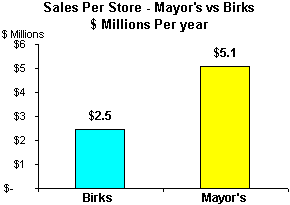IDEX Online Research: Birks + Mayor’s: The Small Fish Swallows The Big Fish
November 01, 05
Jewelry industry consolidation continues. By the end of 2005, a new pan-American jewelry chain, Henry Birks & Sons, will exist, born of the merger of Florida-based Mayor’s Jewelers and Quebec-based Birks Jewelers. This new retail jeweler will operate about 67 stores and is expected to post over $275 million in sales in the current fiscal year ending March 2006, making it the eighth largest jeweler in North America.
This is clearly the proverbial tale of the small fish – Birks with sales of about $97 million last year – acquiring Mayor’s with 2004 sales of about $143 million.
In August 2002, guild-jeweler Birks made a major capital infusion into financially-stressed Mayor’s Jewelers, a publicly held guild jeweler with stores in Florida and Georgia. Since then, the two companies have progressively been moving toward a merger. On November 14, 2005, Mayor’s shareholders (owners of “MYR” shares) will be asked to approve the formal merger of the two companies. IDEX Online Research culled through more than 1,000 pages of legal documents, and the following are our key findings:
- The merger is a “done deal.” A simple majority of shareholders can approve the merger. Birks, which owns 75.8% of MYR shares, and Mayor’s directors, which own 5.0% of MYR shares, have already indicated that they will vote in favor of the merger.
- Current Mayor’s shareholders, who own about 24% of MYR shares (and currently control 24% of the vote) will have just over 2% of the total voting power of the merged Birks / Mayors entity, though they will own 53% of the Birks class A voting shares (one vote per share). Almost all of the remaining voting power – roughly 96% of the vote from the remaining combined class A shares and class B shares (10 votes per share) – will be held by Birks’ owner, Dr. Lorenzo Rossi di Montelera. The remaining 2% of the voting power will be held by directors and officers of the merged company.
- Post-merger, the company can issue an unlimited number of class A shares, class B shares, and preferred shares. Thus, class A common shareholders may find their voting power further diluted.
- Cash dividends will not be paid to common shareholders in the foreseeable future.
- The combined Birks / Mayor’s entity is expected to generate revenue growth of about 10% annually over the next two years, according to projections supplied by management. By 2007, Birks could be posting revenues just over $300 million, as the graph illustrates.
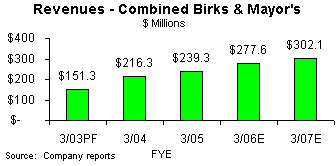 |
- Profits are expected to rise solidly due to merger efficiencies.
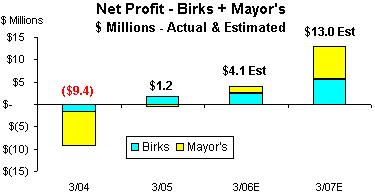 Source: company reports |
- Rolex is the largest supplier to Mayor’s. Our analysis suggests that Rolex accounted for $55 million of Mayor’s sales last year, or about 39% of all revenues. Birks does not carry Rolex in its stores. Industry sources say that Mayor’s is Rolex’s largest retail customer.
- Sales by product category for the merged companies are very different from the typical U.S. jeweler. For example, the typical U.S. independent jeweler generates about 5% of annual revenues from watches. The combined Mayor’s / Birks entity is expected to generate about 46% of annual sales from watches, as the graph below illustrates (Rolex = light blue 23%; other watch brands = medium blue 23%).
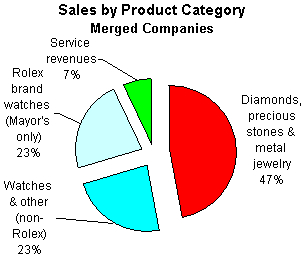 Source: company reports |
- While Birks and Mayor’s average store sizes are about the same – roughly 4,600 square feet – store sales productivity is dramatically different. The average Mayor’s store generates just over twice as much revenue as the typical Birks store, as the graph below illustrates. Even after eliminating Rolex sales from Mayor’s annual revenues, the Florida-based Mayor’s stores still produce significantly greater sales per store than Birks. We note, however, that the typical Jared store, Sterling’s jewelry superstore concept, generates sales of about $5.6 million annually. Jared has Rolex in selected locations only.
|
|
- Birks has consistently generated a higher gross margin than Mayor’s. This is due to two factors, in our opinion: 1) because of lower store sales and inventory turn in Canada, Birks’ margin must be higher to generate profitability for the chain; and, 2) Birks has some manufacturing capacity which keeps profits in-house that would otherwise accrue to suppliers. The typical U.S. jeweler generates a gross margin in the mid-to-high 40% range. The graph below illustrates gross margin disparity between Birks and Mayor’s in the most recent year.
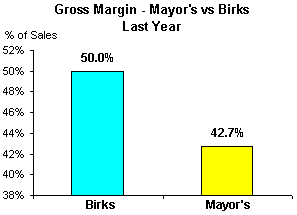 Source: company reports |
- Disclosure of operating metrics in the Birks / Mayor’s legal filings is disappointing. In light of Sarbanes-Oxley, we are surprised that the Securities and Exchange Commission did not require further disclosure. However, the SEC has signed off on the company’s legal filings.
- New stores are likely, and acquisitions are possible. While management did not disclose its new store plans, it did note that acquisitions of similar chains are possible. In our opinion, it will not achieve its sales goals without new stores or acquisitions. Currently, Birks operates 39 stores and Mayor’s operates 28 units.
- While management lists 13 reasons for the merger, there are really only two key reasons, in our opinion.
- Increase operational efficiencies to generate greater profits
- Back door way for Birks to become a U.S. public company
- While MYR shareholders may experience some uneasiness about Mayor’s recent financial restatements and informal investigations by the SEC, we believe that these are not material issues. Arguably, they may result from sloppy accounting; Mayor’s now has a new chief financial officer.
The companies are in registration with the U.S. Securities & Exchange Commission. The facts presented in our analysis are not guaranteed, and our analysis may change. Neither Mayor’s nor Birks’ management could comment on our article, since the company is in registration. The author owns one hundred (100) shares of MYR.
